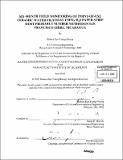Six-month field monitoring of point-of-use ceramic water filter by using H₂S paper strip most probable number method in San Francisco Libre, Nicaragua
Author(s)
Hwang, Rebeca Eun Young, 1979-
DownloadFull printable version (40.76Mb)
Alternative title
6 month field monitoring of point-of-use ceramic water filter by using H₂S paper strip most probable number method in San Francisco Libre, Nicaragua
Other Contributors
Massachusetts Institute of Technology. Dept. of Civil and Environmental Engineering.
Advisor
Susan E. Murcott.
Terms of use
Metadata
Show full item recordAbstract
Monitoring programs are an essential concomitant to household drinking water treatment. The author implemented a 6-month monitoring program to assess the performance of the Potters for Peace (PFP) water filter in San Francisco Libre, Nicaragua. Both analytical methods and surveys were used to study flow-rate, microbiological removal and user acceptance of 100 PFP filters. Results for the 6-month monitoring by using hydrogen sulfide (H2S) Paper Strip Most Probable Number (H2S MPN) showed that an average of 80.4% of the sample population had less than 2.2 H2S producing colonies per 100 mL after filtration through the PFP filter. Six percent of the visited households had more than 16 CFU/100 mL after filtration. Over the 6 months of the study, the level and pattern of contamination did not change significantly. Filtration rate measurements showed that the average PFP flow-rate was 1.7 L/hrs. Membrane Filtration with mColiBlue24® tests were conducted for half of the sample population in the final month of the study. Total Coliform results showed that 30.6% of the studied families had less than 2.2 CFU/100 mL, and 27% had 0 CFU/100 mL for E-coli when initially present. Approximately 45% of the households had more than 16 CFU/100 mL after filtration for Total Coliform. Yet even so average removal rates for the PFP filter overall were 97.6% for E-coli and 89.3% for Total Coliforms. Users mainly complained about the filter's small capacity (20L), and they requested a ceramic instead of a plastic recipient vessel. Filter breakage was appreciable, since 15% of the filters broke by the end of the study. Recontamination of filtered water due to contaminated receptacles was in 33% of cases. Multiple barrier solutions, such as chlorination after filtration, are recommended for PFP filter users. The H2S MPN method's relevance for long-term monitoring programs in developing countries is evaluated in this report. The use of H2S MPN is recommended for rural areas where there are cost constraints in conjunction with a validation system. Validation of H2S MPN may be given by performing parallel tests with other Standard Methods, such as Membrane Filtration (MF). The report also includes a discussion of lessons learned and recommendations for future monitoring programs of household drinking water systems.
Description
Thesis (M.Eng.)--Massachusetts Institute of Technology, Dept. of Civil and Environmental Engineering, 2003. Includes bibliographical references (leaves 109-114).
Date issued
2003Department
Massachusetts Institute of Technology. Department of Civil and Environmental EngineeringPublisher
Massachusetts Institute of Technology
Keywords
Civil and Environmental Engineering.